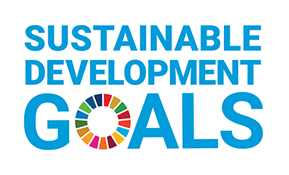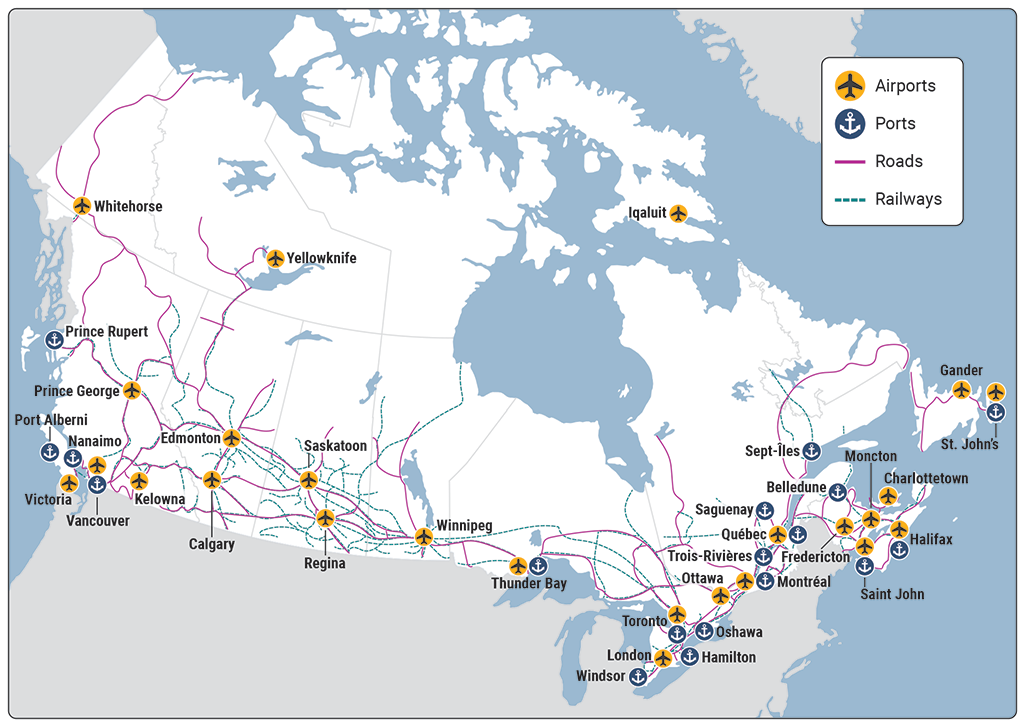2024 Reports 2 to 4 of the Auditor General of Canada to the Parliament of Canada
Report 4—National Trade Corridors Fund—Transport Canada
At a Glance
Overall, Transport Canada did a good job of designing and implementing the National Trade Corridors Fund but did not track and report on its results well. Launched in 2017, the fund has the objective of improving the movement of goods across Canada through the strengthening of its network of roads, rails, airports, and seaports by 2028. These transportation corridors are important to foster trade through imports and exports and contribute to Canada’s economic health.
We found that Transport Canada gathered and used evidence on the status and performance of trade corridors to identify bottlenecks and other fluidity constraints present in the infrastructure of the transportation system. This evidence informed how the department designed the fund and conducted its calls for infrastructure project proposals. For example, a call for project proposals targeted Canadian ports experiencing congestion issues, as shown in the available data. This evidence-based approach supported the selection of projects intended to tackle proven gaps in the infrastructure. The department assessed project proposals using a merit-based approach.
However, we found important weaknesses in how the department tracked and reported on performance. As a result, it was unclear whether projects were having the intended impact. The approach used to assess the success of the fund was not tied to the success of the projects it funded. For the remaining 5 years of the fund, Transport Canada needs to strengthen its results monitoring and reporting systems to properly assess the success of its projects and, ultimately, of the fund.
Key facts and findings
- International trade represents more than 60% of Canada’s gross domestic product and relies on moving goods in and out of the country.
- Transport Canada had launched 7 calls for proposals since 2017, including 2 that targeted the Arctic and northern region.
- The department assessed project proposals using a merit-based approach but could not demonstrate on what basis it prioritized some meritorious projects over others.
- Transport Canada had approved $3.8 billion to fund 181 transportation projects. About 20% ($711 million) of the approved budget was spent between 2017 and 2023.
- Half of the funded projects had an incomplete performance measurement strategy to assess their results.
Why we did this audit
- Improving Canada’s trade-related transportation infrastructure contributes to the country’s economic success, improving the quality of life for Canadians.
- Transport Canada must be aware of the needs and opportunities in Canada’s transportation corridors to make informed decisions and demonstrate accountability.
- Assessing the project proposals based on merit and then selecting which ones are recommended for funding are essential steps in prioritizing limited funding and ensuring that transportation needs are met.
- Monitoring and reporting on results help Transport Canada to determine whether the funding provided is being used to meet the intended outcomes of the National Trade Corridors Fund.
Highlights of our recommendations
- In support of the transparency and fairness of the project selection process, Transport Canada should document the review committees’ work, including the rationale used when validating project evaluation scores and applying additional considerations for identifying which proposals to recommend for funding.
- Transport Canada should strengthen project-level performance evaluation and monitoring to allow the consistent and timely gathering of performance information for future projects and those underway and to allow the roll-up of results from individual funded projects to inform program-level performance and accountability.
Please see the full report to read our complete findings, analysis, recommendations and the audited organizations’ responses.



In terms of its contribution to the achievement of the United Nations’ Sustainable Development Goals and targets, Transport Canada identified the National Trade Corridors Fund as a program that contributes to the achievement of Goal 9 (Industry, Innovation and Infrastructure) and Goal 13 (Climate Action) and the following associated targets:
- Target 9.1: “Develop quality, reliable, sustainable and resilient infrastructure, including regional and transborder infrastructure, to support economic development and human well-being, with a focus on affordable and equitable access for all.” This is measured by indicator 9.1.2: “Passenger and freight volumes, by mode of transport.”
- Target 9.4: “By 2030, upgrade infrastructure and retrofit industries to make them sustainable, with increased resource-use efficiency and greater adoption of clean and environmentally sound technologies and industrial processes, with all countries taking action in accordance with their respective capabilities.” This is measured by indicator 9.4.1: “carbon dioxideCO2 emission per unit of value added.”
- Target 13.1: “Strengthen resilience and adaptive capacity to climate-related hazards and natural disasters in all countries.”
Visit our Sustainable Development page to learn more about sustainable development and the Office of the Auditor General of CanadaOAG.
Exhibit highlights
Selected components of Canada’s trade-related transportation system

Source: Based on data from Transport Canada
Text version
This map shows where 4 selected components of Canada’s trade-related transportation system are located. The selected components are airports, ports, roads, and railways.
The map indicates the cities in which 25 airports and 17 ports are located. Airports are spread out across Canada; however, most ports are located in the eastern part of the country. By province, the airports and ports are located as follows:
- In British Columbia, there are 4 airports and 4 ports. The airports are located in Victoria, Vancouver, Prince George, and Kelowna, and the ports are located in Port Alberni, Prince Rupert, Nanaimo, and Vancouver.
- In Alberta, there are 2 airports, but there are no ports. The airports are located in Calgary and Edmonton.
- In Saskatchewan, there are 2 airports, but there are no ports. The airports are located in Saskatoon and Regina.
- In Manitoba, there is 1 airport, but there are no ports. The airport is located in Winnipeg.
- In Ontario, there are 4 airports and 5 ports. The airports are located in Thunder Bay, London, Toronto, and Ottawa, and the ports are located in Thunder Bay, Windsor, Toronto, Hamilton, and Oshawa.
- In Quebec, there are 2 airports and 4 ports. The airports are located in Montréal and Québec, and the ports are located in Trois‑Rivières, Montréal, Saguenay, and Sept-Îles.
- In New Brunswick, there are 3 airports and 2 ports. The airports are located in Fredericton, Saint John, and Moncton, and the ports are located in Belledune and Saint John.
- In Nova Scotia, there is 1 airport and there is 1 port, both of which are located in Halifax.
- In Prince Edward Island, there is 1 airport, but there are no ports. The airport is located in Charlottetown.
- In Newfoundland and Labrador, there are 2 airports and 1 port. The airports are located in Gander and St. John’s, and the port is located in St. John’s.
- In Yukon, there is 1 airport, but there are no ports. The airport is located in Whitehorse.
- In the Northwest Territories, there is 1 airport, but there are no ports. The airport is located in Yellowknife.
- In Nunavut, there is 1 airport, but there are no ports. The airport is located in Iqaluit.
With respect to roads and railways, the map shows that roads are most prevalent across Canada. Although railways are also located across Canada, they are most prevalent in the Prairies, especially in southern Saskatchewan. However, in the territories, only a few roads lead to capital cities and main areas, and no roads are shown in Nunavut. There are also no railways in the territories, except for a short one into Whitehorse.
The calls for proposals for the National Trade Corridors Fund had specific objectives that evolved to target transportation system needs
| Call for proposals (dates) |
Objective | Targeted recipients | Funding approved (number of projects)Note * |
|---|---|---|---|
|
Call 1: First national call (July to November 2017) |
Support the fluidity of Canadian trade by alleviating capacity constraints and bottlenecks, and strengthen the connections between the various modes of transportation. |
Open to all |
$890 million (39 projects) |
|
Call 2: Northern call (November 2018 to March 2019) |
Address the unique transportation needs and priorities of Canada’s North. |
Projects that target or are located in Yukon, the Northwest Territories, or Nunavut |
$316 million (11 projects) |
|
Call 3: Continuous call for trade diversification (January 2019 to December 2021) |
Diversify trade to overseas markets in support of the Government of Canada’s Export Diversification Strategy. |
Open to all |
$1.4 billion (62 projects) |
|
Call 4: Arctic and northern call (October 2020 to March 2021) |
Address the unique transportation needs and priorities of Canada’s Arctic and northern communities. |
Projects that target or are located in Yukon, the Northwest Territories, Nunavut, Nunatsiavut (northern Labrador), Nunavik (northern Quebec), or Churchill (northern Manitoba) |
$217 million (16 projects) |
|
Call 5: Increase the fluidity of Canada’s supply chains (December 2021 to June 2022) |
Build supply chain capacity under 2 themes: “Strengthening Canada’s Connections to Global Markets” and “Building Internal Trade Corridors.” |
Open to all |
$965 million (44 projects) |
|
Call 6: Relieving supply chain congestion at Canadian ports (January to February 2022) |
Immediately relieve supply chain congestion at certain Canadian ports. |
Canadian port authorities and partners |
$28 million (9 projects) |
|
Call 7: Advancing supply chain digitalization (February to April 2023) |
Through industry‑led projects, improve asset and operations management, coordination, planning, and optimization of supply chains; alleviate bottlenecks; and boost network fluidity. |
Not-for-profit and for‑profit organizations, Canadian port authorities, and the National Airport System airport authorities. |
Decision pending |
Note: See Exhibit 4.4 and Exhibit 4.5 for information about the status of projects and expenditures.
Source: Based on data from Transport Canada.
Many projects had missing or incomplete performance measurement strategies
| Status of performance measurement strategy | Number of national projects, excluding Arctic and northern projects (representative sample of 34 out of 86) |
Number of Arctic and northern projects (representative sample of 20 out of 30) |
Total (representative sample of 54 out of 116) |
|---|---|---|---|
| Complete performance measurement strategy was in place | 23 out of 34 (68%) |
1 out of 20 (5%) |
24 out of 54 (44%) |
| Performance measurement strategy in place but incomplete because performance indicators missing either a target, a baseline, or a focus on results | 8 out of 34 (24%) |
19 out of 20 (95%) |
27 out of 54 (50%) |
| No performance measurement strategy in place | 3 out of 34 (9%) |
0 out of 20 (0%) |
3 out of 54 (6%) |
Source: Based on data from Transport Canada
Related information
Entities
Tabling date
- 19 March 2024
Related audits
- 2021 Reports of the Auditor General of Canada to the Parliament of Canada
Report 9—Investing in Canada Plan
Parliamentary hearings
